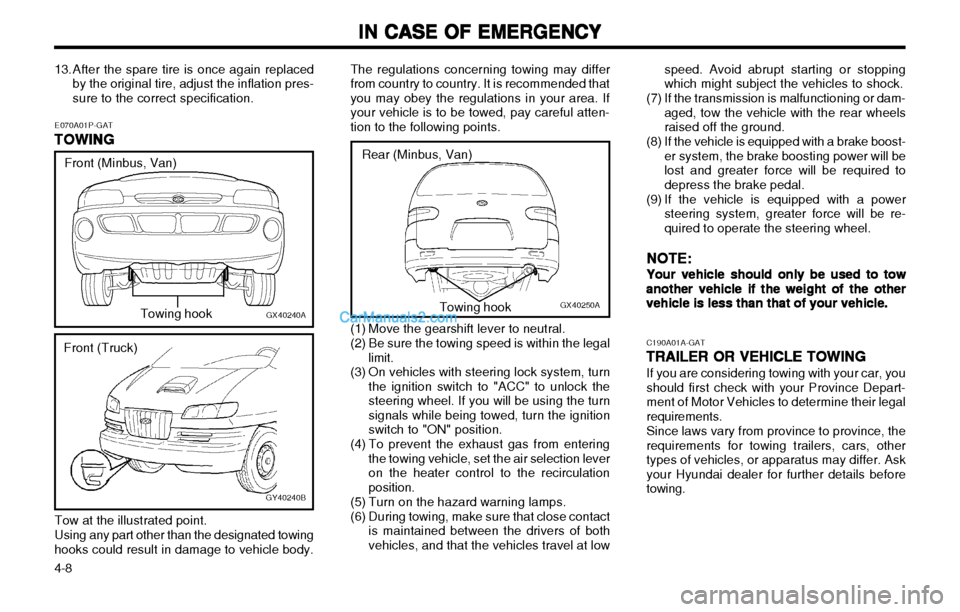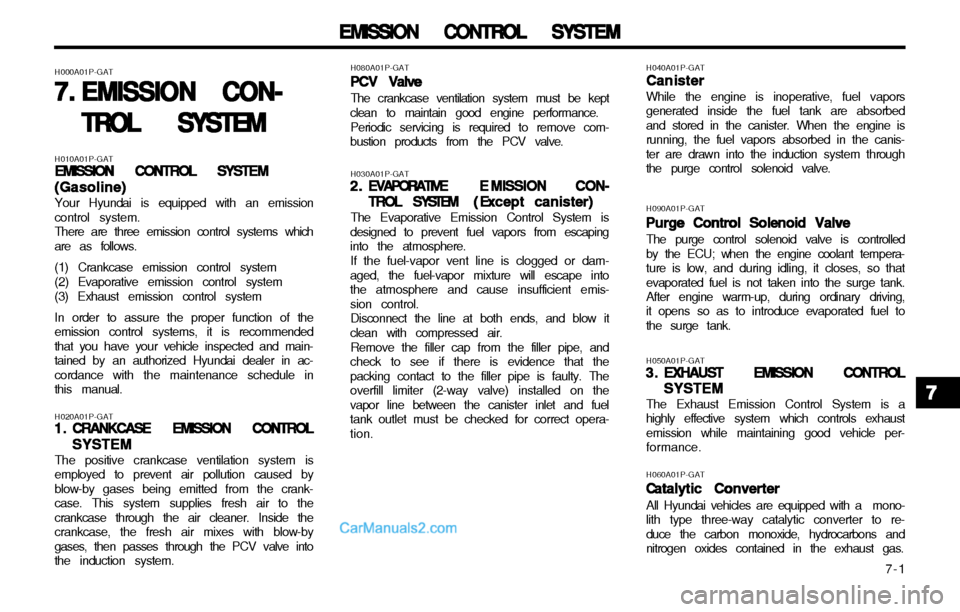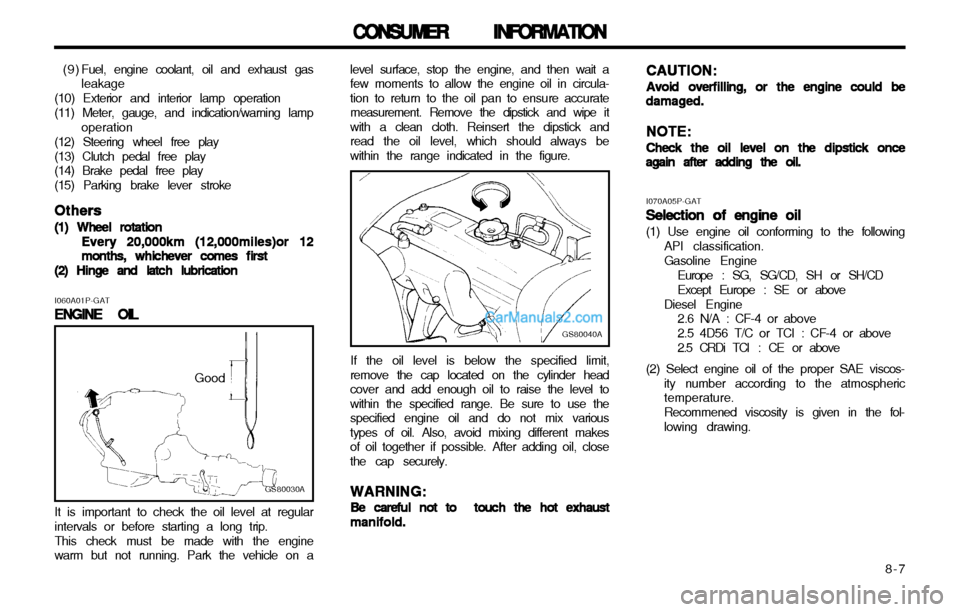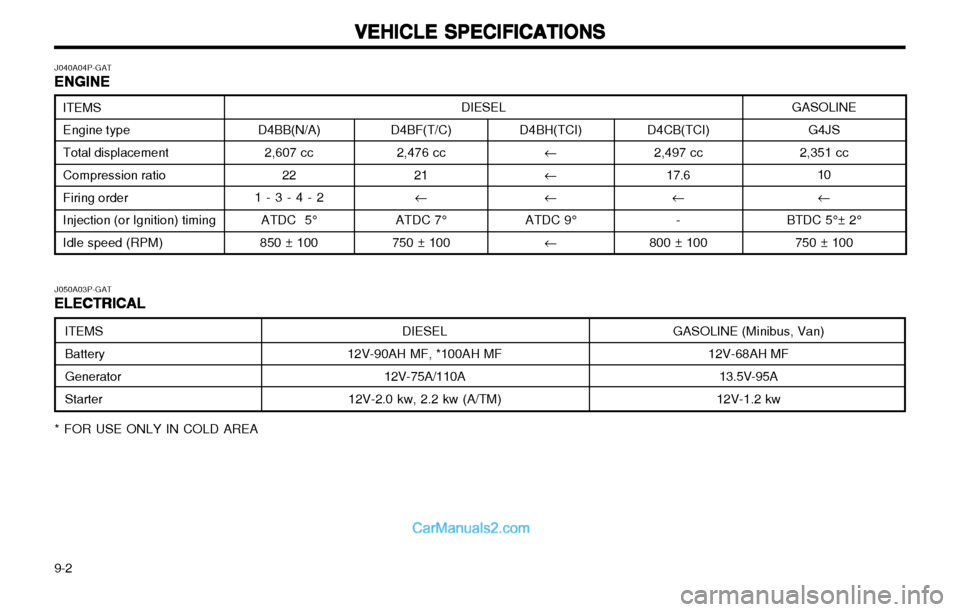2003 Hyundai H-1 (Grand Starex) gas type
[x] Cancel search: gas typePage 123 of 173

IN CASE OF EMERGENCY
IN CASE OF EMERGENCY IN CASE OF EMERGENCY
IN CASE OF EMERGENCY
IN CASE OF EMERGENCY
4-8 The regulations concerning towing may differ from country to country. It is recommended thatyou may obey the regulations in your area. Ifyour vehicle is to be towed, pay careful atten-tion to the following points.
C190A01A-GATTRAILER OR VEHICLE TOWING
TRAILER OR VEHICLE TOWING TRAILER OR VEHICLE TOWING
TRAILER OR VEHICLE TOWING
TRAILER OR VEHICLE TOWING
If you are considering towing with your car, youshould first check with your Province Depart-ment of Motor Vehicles to determine their legal requirements.Since laws vary from province to province, the requirements for towing trailers, cars, othertypes of vehicles, or apparatus may differ. Askyour Hyundai dealer for further details beforetowing.
GX40250A
Rear (Minbus, Van)Towing hook
(1) Move the gearshift lever to neutral.
(2) Be sure the towing speed is within the legal limit.
(3) On vehicles with steering lock system, turn the ignition switch to "ACC" to unlock the steering wheel. If you will be using the turnsignals while being towed, turn the ignitionswitch to "ON" position.
(4) To prevent the exhaust gas from entering the towing vehicle, set the air selection leveron the heater control to the recirculationposition.
(5) Turn on the hazard warning lamps.
(6) During towing, make sure that close contact is maintained between the drivers of both vehicles, and that the vehicles travel at low speed. Avoid abrupt starting or stoppingwhich might subject the vehicles to shock.
(7) If the transmission is malfunctioning or dam- aged, tow the vehicle with the rear wheelsraised off the ground.
(8) If the vehicle is equipped with a brake boost- er system, the brake boosting power will belost and greater force will be required todepress the brake pedal.
(9) If the vehicle is equipped with a power steering system, greater force will be re-quired to operate the steering wheel.
NOTE:
NOTE: NOTE:
NOTE:
NOTE:
Your vehicle should only be used to tow
Your vehicle should only be used to tow Your vehicle should only be used to tow
Your vehicle should only be used to tow
Your vehicle should only be used to tow another vehicle if the weight of the other
another vehicle if the weight of the other another vehicle if the weight of the other
another vehicle if the weight of the other
another vehicle if the weight of the other
vehicle is less than that of your vehicle.
vehicle is less than that of your vehicle. vehicle is less than that of your vehicle.
vehicle is less than that of your vehicle.
vehicle is less than that of your vehicle.
E070A01P-GAT
TOWING
TOWING TOWING
TOWING
TOWING
GX40240A
Front (Minbus, Van)
Towing hook
Tow at the illustrated point. Using any part other than the designated towing
hooks could result in damage to vehicle body.
GY40240B
Front (Truck)
13. After the spare tire is once again replaced
by the original tire, adjust the inflation pres- sure to the correct specification.
Page 131 of 173

IN CASE OF EMERGENCY
IN CASE OF EMERGENCY IN CASE OF EMERGENCY
IN CASE OF EMERGENCY
IN CASE OF EMERGENCY
4-16 A bulb should only be replaced with a new bulb of the same rating and type. The designationcan be found on the base of the bulb. Headlight, upper/lower beam ................ 60/55WFront turn-signal lamps ................................ 21WPosition lamps ............................................... 5WRear turn-signal lamps ................................. 21W Reversing lamps .......................................... 21W Licence-plate lamps ....................................... 5WStop and tail lamps ................................. 21/5WFront fog lamp .............................................. 55WSide repeater lamp ....................................... 5WRear fog lamp ............................................ 21W
E130D01P-1
Truck
E130B01P-1
E130C01P-1
Truck
Minibus/Van
E130B01P-GAT Bulb capacity
Bulb capacity Bulb capacity
Bulb capacity
Bulb capacity
E130A01P-1
Minibus/Van
E130A02P-GAT
REPLACEMENT OF LAMP BULBS
REPLACEMENT OF LAMP BULBS REPLACEMENT OF LAMP BULBS
REPLACEMENT OF LAMP BULBS
REPLACEMENT OF LAMP BULBS
Before replacing a bulb, be sure the light is off.
Do not touch the glass part of the new bulb with your bare fingers; the skin oil left on the glasswill evaporate when the bulb gets hot and thevapor will condense on the reflector and dim thesurface.
CAUTION:
CAUTION: CAUTION:
CAUTION:
CAUTION:
Keep the lamps out of contact with petro-
Keep the lamps out of contact with petro- Keep the lamps out of contact with petro-
Keep the lamps out of contact with petro-
Keep the lamps out of contact with petro- leum product, such as oil, gasoline, etc.
leum product, such as oil, gasoline, etc. leum product, such as oil, gasoline, etc.
leum product, such as oil, gasoline, etc.
leum product, such as oil, gasoline, etc.(2)(2)
(2)(2)
(2)
Never use a fuse with a capacity larger
Never use a fuse with a capacity larger Never use a fuse with a capacity larger
Never use a fuse with a capacity larger
Never use a fuse with a capacity larger
than that specified or any substitute, such
than that specified or any substitute, such than that specified or any substitute, such
than that specified or any substitute, such
than that specified or any substitute, such
as wire, foil, etc.;doing so will cause the
as wire, foil, etc.;doing so will cause the as wire, foil, etc.;doing so will cause the
as wire, foil, etc.;doing so will cause the
as wire, foil, etc.;doing so will cause the
circuit wiring to heat up and can cause a
circuit wiring to heat up and can cause a circuit wiring to heat up and can cause a
circuit wiring to heat up and can cause a
circuit wiring to heat up and can cause a
fire.fire.
fire.fire.
fire.
Page 145 of 173

PREVENTIVE MAINTENANCE
PREVENTIVE MAINTENANCE PREVENTIVE MAINTENANCE
PREVENTIVE MAINTENANCE
PREVENTIVE MAINTENANCE
6-8 GASOLINE DIESEL
E VERY
Except E.C EV ERY 3,000 KM
5,000 KM EV ERY 4,000 KM (Except 2.5 CRDi)
or 3 MONTHS EV ERY 7,500 KM or 6 MONTHS (2.5 CRDi only)
MORE FREQUENTLY
MORE FREQUENTLY
EV ERY 60,000 K M or 4 8 MONTHS (Except 2.5 CRDi)
MORE FREQUENTLY
MORE FREQUENTLY
EV ERY 10,000 K M o r 6 MONTHS
MORE FREQUENTLY
EV ERY 100,000 K M
EV ERY 40,000 K M
EV ERY 45 ,000 K M
R R R R
I II
RR R
G070A06P-GAT
MAINTENANCE UNDER SEVERE USAGE CONDITIONS
MAINTENANCE UNDER SEVERE USAGE CONDITIONS MAINTENANCE UNDER SEVERE USAGE CONDITIONS
MAINTENANCE UNDER SEVERE USAGE CONDITIONS
MAINTENANCE UNDER SEVERE USAGE CONDITIONS
The following items must be serviced more frequently on cars normally used under severe driving conditions. Refer to the chart below for the appropriate
maintenance intervals.
R : REPLACE I : INSPECT AND, AFTER INSPECTION, CLEAN, ADJUST, REPAIR OR REPLACE IF NECESSARY
ENGINE OIL AND FILTER AIR CLEANER FILTER SPARK PLUGS TIMING BELT BRAKE PADS, CALIPERS, ROTORSREAR BRAKE DRUMS/LININGSSTEERING GEAR BOX, LINKAGE & BOOTS
AIR FILTER (F o r Evaporator and Blower unit)
MANUAL TRANSMISSION OIL AUTOMATIC TRANSMISSION OIL A, B, C, F, H C, E B, H D, E, F, G C, D, G, HC, D, G, HC, D, E, FC,EA, C, D, E, F, G, H, I, J A, C, E, F, G, H, I
SEVERE DRIVING CONDITIONS
SEVERE DRIVING CONDITIONS SEVERE DRIVING CONDITIONS
SEVERE DRIVING CONDITIONS
SEVERE DRIVING CONDITIONS
A - Repeated short distance driving
B - Extensive idling
C - Driving in dusty conditions
D - Driving in areas using salt or other corrosive materials or in very cold weatherE - Driving in sandy areas
F - More than 50% driving in heavy city traffic during hot above 32°C (90°F)
G - Driving in mountainous areas
H - Towing a trailer or police car, taxi, or commercial type operation
I - Driving for patrol car, taxi, commercial car or vehicle towing
J - Driving over 170 km/h
For E.C
MAINTENANCE ITEM MAINTENANCE
OPERATION MAINTENANCE
INTERVALS DRIVING
CONDITION
Except E.C For E.C
Page 148 of 173

7-1
EMISSION CONTROL SYSTEM
EMISSION CONTROL SYSTEM EMISSION CONTROL SYSTEM
EMISSION CONTROL SYSTEM
EMISSION CONTROL SYSTEM
H030A01P-GAT2.2.
2.2.
2.
EE
EE
E
VAPORATIVE
VAPORATIVE VAPORATIVE
VAPORATIVE
VAPORATIVE E
E E
E
E MISSION CON-
MISSION CON- MISSION CON-
MISSION CON-
MISSION CON-
TROL
TROL TROL
TROL
TROL SS
SS
S YSTEM
YSTEM YSTEM
YSTEM
YSTEM (
( (
(
( EE
EE
E xcept canister)
xcept canister) xcept canister)
xcept canister)
xcept canister)
The Evaporative Emission Control System is
designed to prevent fuel vapors from escaping into the atmosphere.
If the fuel-vapor vent line is clogged or dam-
aged, the fuel-vapor mixture will escape intothe atmosphere and cause insufficient emis-sion control. Disconnect the line at both ends, and blow it
clean with compressed air.
Remove the filler cap from the filler pipe, and
check to see if there is evidence that thepacking contact to the filler pipe is faulty. Theoverfill limiter (2-way valve) installed on thevapor line between the canister inlet and fueltank outlet must be checked for correct opera-tion. H050A01P-GAT
3.3.
3.3.
3.
EXHAUST EMISSION CONTROL
EXHAUST EMISSION CONTROL EXHAUST EMISSION CONTROL
EXHAUST EMISSION CONTROL
EXHAUST EMISSION CONTROL
SYSTEM
SYSTEM SYSTEM
SYSTEM
SYSTEM
The Exhaust Emission Control System is a
highly effective system which controls exhaustemission while maintaining good vehicle per-formance.
H060A01P-GATCC
CC
C
atalytic Converter
atalytic Converter atalytic Converter
atalytic Converter
atalytic Converter
All Hyundai vehicles are equipped with a mono-
lith type three-way catalytic converter to re-duce the carbon monoxide, hydrocarbons andnitrogen oxides contained in the exhaust gas.
H000A01P-GAT
7.7.
7.7.
7.
EMISSION CON-
EMISSION CON- EMISSION CON-
EMISSION CON-
EMISSION CON-
TROL SYSTEM
TROL SYSTEM TROL SYSTEM
TROL SYSTEM
TROL SYSTEM
H010A01P-GAT EMISSION CONTROL SYSTEM
EMISSION CONTROL SYSTEM EMISSION CONTROL SYSTEM
EMISSION CONTROL SYSTEM
EMISSION CONTROL SYSTEM
(Gasoline)
(Gasoline) (Gasoline)
(Gasoline)
(Gasoline) Your Hyundai is equipped with an emission
control system. There are three emission control systems which
are as follows.
(1) Crankcase emission control system (2) Evaporative emission control system(3) Exhaust emission control system In order to assure the proper function of the
emission control systems, it is recommended that you have your vehicle inspected and main-tained by an authorized Hyundai dealer in ac-cordance with the maintenance schedule inthis manual.
H020A01P-GAT1.1.
1.1.
1.
CRANKCASE EMISSION CONTROL
CRANKCASE EMISSION CONTROL CRANKCASE EMISSION CONTROL
CRANKCASE EMISSION CONTROL
CRANKCASE EMISSION CONTROL
SYSTEM
SYSTEM SYSTEM
SYSTEM
SYSTEM
The positive crankcase ventilation system is
employed to prevent air pollution caused byblow-by gases being emitted from the crank-case. This system supplies fresh air to thecrankcase through the air cleaner. Inside thecrankcase, the fresh air mixes with blow-bygases, then passes through the PCV valve intothe induction system. H080A01P-GAT
PCV Valve
PCV Valve PCV Valve
PCV Valve
PCV Valve
The crankcase ventilation system must be kept
clean to maintain good engine performance.
Periodic servicing is required to remove com-
bustion products from the PCV valve. H040A01P-GAT
Canister
Canister Canister
Canister
Canister While the engine is inoperative, fuel vapors
generated inside the fuel tank are absorbed and stored in the canister. When the engine isrunning, the fuel vapors absorbed in the canis-ter are drawn into the induction system throughthe purge control solenoid valve.
H090A01P-GATPurge Control Solenoid Valve
Purge Control Solenoid Valve Purge Control Solenoid Valve
Purge Control Solenoid Valve
Purge Control Solenoid Valve
The purge control solenoid valve is controlled
by the ECU; when the engine coolant tempera-ture is low, and during idling, it closes, so thatevaporated fuel is not taken into the surge tank.After engine warm-up, during ordinary driving, it opens so as to introduce evaporated fuel to the surge tank.
77
77
7
Page 156 of 173

8-7
CONSUMER INFORMATION
CONSUMER INFORMATION CONSUMER INFORMATION
CONSUMER INFORMATION
CONSUMER INFORMATION
( 9 ) Fuel, engine coolant, oil and exhaust gas leakage
(10) Exterior and interior lamp operation (11) Meter, gauge, and indication/warning lamp operation
(12) Steering wheel free play(13) Clutch pedal free play (14) Brake pedal free play (15) Parking brake lever stroke
Others
Others Others
Others
Others
(1) Wheel rotation
(1) Wheel rotation (1) Wheel rotation
(1) Wheel rotation
(1) Wheel rotation
Every 20,000km (12,000miles)or 12
Every 20,000km (12,000miles)or 12 Every 20,000km (12,000miles)or 12
Every 20,000km (12,000miles)or 12
Every 20,000km (12,000miles)or 12
months, whichever comes first
months, whichever comes first months, whichever comes first
months, whichever comes first
months, whichever comes first
(2) Hinge and latch lubrication
(2) Hinge and latch lubrication (2) Hinge and latch lubrication
(2) Hinge and latch lubrication
(2) Hinge and latch lubrication level surface, stop the engine, and then wait a few moments to allow the engine oil in circula-tion to return to the oil pan to ensure accuratemeasurement. Remove the dipstick and wipe itwith a clean cloth. Reinsert the dipstick andread the oil level, which should always bewithin the range indicated in the figure.
GS80030A
Good
I060A01P-GAT
ENGINE OIL
ENGINE OIL ENGINE OIL
ENGINE OIL
ENGINE OIL
It is important to check the oil level at regular
intervals or before starting a long trip.
This check must be made with the engine
warm but not running. Park the vehicle on a
GS80040A
If the oil level is below the specified limit,
remove the cap located on the cylinder head cover and add enough oil to raise the level towithin the specified range. Be sure to use thespecified engine oil and do not mix varioustypes of oil. Also, avoid mixing different makesof oil together if possible. After adding oil, closethe cap securely.
WARNING:
WARNING: WARNING:
WARNING:
WARNING:
Be careful not to touch the hot exhaust
Be careful not to touch the hot exhaust Be careful not to touch the hot exhaust
Be careful not to touch the hot exhaust
Be careful not to touch the hot exhaust manifold.
manifold. manifold.
manifold.
manifold. CAUTION:
CAUTION: CAUTION:
CAUTION:
CAUTION:
Avoid overfilling, or the engine could be
Avoid overfilling, or the engine could be Avoid overfilling, or the engine could be
Avoid overfilling, or the engine could be
Avoid overfilling, or the engine could bedamaged.
damaged. damaged.
damaged.
damaged.
NOTE:
NOTE: NOTE:
NOTE:
NOTE:
Check the oil level on the dipstick once
Check the oil level on the dipstick once Check the oil level on the dipstick once
Check the oil level on the dipstick once
Check the oil level on the dipstick onceagain after adding the oil.
again after adding the oil. again after adding the oil.
again after adding the oil.
again after adding the oil.
I070A05P-GATSelection of engine oil
Selection of engine oil Selection of engine oil
Selection of engine oil
Selection of engine oil (1) Use engine oil conforming to the following
API classification. Gasoline Engine
Europe : SG, SG/CD, SH or SH/CDExcept Europe : SE or above
Diesel Engine 2.6 N/A : CF-4 or above2.5 4D56 T/C or TCI : CF-4 or above
2.5 CRDi TCI : CE or above
(2) Select engine oil of the proper SAE viscos- ity number according to the atmospheric temperature. Recommened viscosity is given in the fol- lowing drawing.
Page 159 of 173

CONSUMER INFORMATION
CONSUMER INFORMATION CONSUMER INFORMATION
CONSUMER INFORMATION
CONSUMER INFORMATION
8-10 I100A02P-GAT
BRAKE FLUID
BRAKE FLUID BRAKE FLUID
BRAKE FLUID
BRAKE FLUID
I100A01P-GAG
MAX MIN
Check the brake fluid level in the reservoir. The brake fluid level must be between the "MAX" and "MIN" marks on the reservoir.The fluid level falls slightly with wear of thebrake pads but it does not indicate any abnor-mality. If the brake fluid level falls markedly in a short time, it indicates leaks from the brake system.In such a case, have your vehicle checked byan authorized HYUNDAI dealer. Use SAE J1703 (or DOT3 or DOT 4) or equiva-lent type brake fluid. On a vehicle with the brake fluid warning lamp, the brake fluid level is monitored by a float.When the brake fluid level falls to below the"MIN" mark, the brake fluid warning lamp lightsup.
WARNING:
WARNING: WARNING:
WARNING:
WARNING:
(1)(1)
(1)(1)
(1) Use only the specified brake fluid. Also,
Use only the specified brake fluid. Also, Use only the specified brake fluid. Also,
Use only the specified brake fluid. Also,
Use only the specified brake fluid. Also,
the additives in different brands may
the additives in different brands may the additives in different brands may
the additives in different brands may
the additives in different brands may
result in a chemical reaction when mixed
result in a chemical reaction when mixed result in a chemical reaction when mixed
result in a chemical reaction when mixed
result in a chemical reaction when mixed
together, so avoid mixing different
together, so avoid mixing different together, so avoid mixing different
together, so avoid mixing different
together, so avoid mixing different
brands if possible.
brands if possible. brands if possible.
brands if possible.
brands if possible.
(2)(2)
(2)(2)
(2) Use extreme caution in filling the brake
Use extreme caution in filling the brake Use extreme caution in filling the brake
Use extreme caution in filling the brake
Use extreme caution in filling the brake
fluid because it is toxic and corrosive,
fluid because it is toxic and corrosive, fluid because it is toxic and corrosive,
fluid because it is toxic and corrosive,
fluid because it is toxic and corrosive,
and it can harm your eyes and damage
and it can harm your eyes and damage and it can harm your eyes and damage
and it can harm your eyes and damage
and it can harm your eyes and damage
painted surface. If the fluid gets in your
painted surface. If the fluid gets in your painted surface. If the fluid gets in your
painted surface. If the fluid gets in your
painted surface. If the fluid gets in your
eyes, flush your eyes with clean water.
eyes, flush your eyes with clean water. eyes, flush your eyes with clean water.
eyes, flush your eyes with clean water.
eyes, flush your eyes with clean water.
I110A01P-GAT CLUTCH FLUID (If installed)
CLUTCH FLUID (If installed) CLUTCH FLUID (If installed)
CLUTCH FLUID (If installed)
CLUTCH FLUID (If installed)
In the case of vehicles with the hydraulic oper- ating clutch, the reservoir for the clutch fluidalso serves as the reservoir for the brake fluid.See the paragraph on the brake fluid.
Irritation to eyes or skin from contact
Irritation to eyes or skin from contact Irritation to eyes or skin from contact
Irritation to eyes or skin from contact
Irritation to eyes or skin from contact
with electrolyte requires immediate med-
with electrolyte requires immediate med- with electrolyte requires immediate med-
with electrolyte requires immediate med-
with electrolyte requires immediate med-
ical attention.
ical attention. ical attention.
ical attention.
ical attention.
(5)(5)
(5)(5)
(5)
If the battery is to be quick-charged, first
If the battery is to be quick-charged, first If the battery is to be quick-charged, first
If the battery is to be quick-charged, first
If the battery is to be quick-charged, first
disconnect the battery cables.
disconnect the battery cables. disconnect the battery cables.
disconnect the battery cables.
disconnect the battery cables.
(6)(6)
(6)(6)
(6) In order to prevent a short circuit, be
In order to prevent a short circuit, be In order to prevent a short circuit, be
In order to prevent a short circuit, be
In order to prevent a short circuit, be
sure to disconnect the negative (-) ter-
sure to disconnect the negative (-) ter- sure to disconnect the negative (-) ter-
sure to disconnect the negative (-) ter-
sure to disconnect the negative (-) ter-
minal before doing anything else.
minal before doing anything else. minal before doing anything else.
minal before doing anything else.
minal before doing anything else.
I090C01P-GAT
Disconnection and connection
Disconnection and connection Disconnection and connection
Disconnection and connection
Disconnection and connection
Never disconnect the battery while the engine
is running; doing so could damage the vehicle’selectrical components. First disconnect thenegative terminal and then the positive termi-nal. When connecting the battery, first connectthe positive terminal and then the negativeterminal.
CAUTION:
CAUTION: CAUTION:
CAUTION:
CAUTION:
(1)(1)
(1)(1)
(1)
Keep the terminals clean. After the bat-
Keep the terminals clean. After the bat- Keep the terminals clean. After the bat-
Keep the terminals clean. After the bat-
Keep the terminals clean. After the bat-
tery is connected, apply terminal protec-
tery is connected, apply terminal protec- tery is connected, apply terminal protec-
tery is connected, apply terminal protec-
tery is connected, apply terminal protec-
tion grease. To clean the terminals, use
tion grease. To clean the terminals, use tion grease. To clean the terminals, use
tion grease. To clean the terminals, use
tion grease. To clean the terminals, use
lukewarm water.
lukewarm water. lukewarm water.
lukewarm water.
lukewarm water.
(2)(2)
(2)(2)
(2) Never short-circuit the battery; doing so
Never short-circuit the battery; doing so Never short-circuit the battery; doing so
Never short-circuit the battery; doing so
Never short-circuit the battery; doing so
could cause it to overheat and be dam-
could cause it to overheat and be dam- could cause it to overheat and be dam-
could cause it to overheat and be dam-
could cause it to overheat and be dam-
aged.
aged. aged.
aged.
aged.
(3)(3)
(3)(3)
(3) Do not smoke or bring an open flame
Do not smoke or bring an open flame Do not smoke or bring an open flame
Do not smoke or bring an open flame
Do not smoke or bring an open flame
near the battery; doing so could ignite
near the battery; doing so could ignite near the battery; doing so could ignite
near the battery; doing so could ignite
near the battery; doing so could ignite
the explosive gas generated by the bat-
the explosive gas generated by the bat- the explosive gas generated by the bat-
the explosive gas generated by the bat-
the explosive gas generated by the bat-
tery.
tery. tery.
tery.
tery.
(4)(4)
(4)(4)
(4) The battery electrolyte is extremely caus-
The battery electrolyte is extremely caus- The battery electrolyte is extremely caus-
The battery electrolyte is extremely caus-
The battery electrolyte is extremely caus-
tic. Do not allow it to come in contact
tic. Do not allow it to come in contact tic. Do not allow it to come in contact
tic. Do not allow it to come in contact
tic. Do not allow it to come in contact
with your eyes, skin, clothing, or the
with your eyes, skin, clothing, or the with your eyes, skin, clothing, or the
with your eyes, skin, clothing, or the
with your eyes, skin, clothing, or the
painted surfaces of the vehicle.
painted surfaces of the vehicle. painted surfaces of the vehicle.
painted surfaces of the vehicle.
painted surfaces of the vehicle.
Spilled electrolyte should be flushed im-
Spilled electrolyte should be flushed im- Spilled electrolyte should be flushed im-
Spilled electrolyte should be flushed im-
Spilled electrolyte should be flushed im-
mediately with ample amounts of water.
mediately with ample amounts of water. mediately with ample amounts of water.
mediately with ample amounts of water.
mediately with ample amounts of water.
o Charge batteries only in a well ventilated
area.
o Do not permit flames, sparks or smoking in the area.
o Keep children away from the area.
Page 166 of 173

VEHICLE SPECIFICATIONS
VEHICLE SPECIFICATIONS VEHICLE SPECIFICATIONS
VEHICLE SPECIFICATIONS
VEHICLE SPECIFICATIONS
9-2 D4BH(TCI)
� � �
ATDC 9° �
D4BF(T/C)
2,476 cc
21�
ATDC 7°
750 ± 100
J040A04P-GAT
ENGINE
ENGINE ENGINE
ENGINE
ENGINE
ITEMS Engine type Total displacement Compression ratio Firing order Injection (or Ignition) timing Idle speed (RPM) D4BB(N/A)
2,607 cc
22
1 - 3 - 4 - 2
ATDC 5°
850 ± 100DIESEL
DIESEL
12V-90AH MF, *100AH MF 12V-75A/110A
12V-2.0 kw, 2.2 kw (A/TM)ITEMS Battery Generator Starter
J050A03P-GAT ELECTRICAL
ELECTRICAL ELECTRICAL
ELECTRICAL
ELECTRICAL
GASOLINE (Minibus, Van)12V-68AH MF13.5V-95A
12V-1.2 kw
* FOR USE ONLY IN COLD AREA
GASOLINE G4JS
2,351 cc 10
�
BTDC 5°± 2°
750 ± 100
D4CB(TCI)
2,497 cc
17.6�
-
800 ± 100